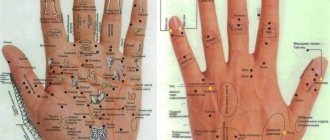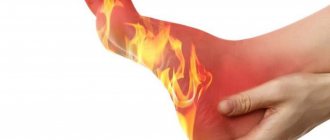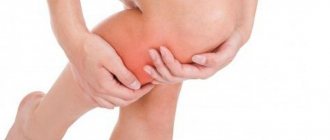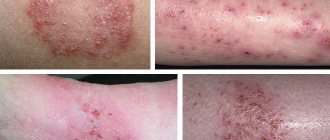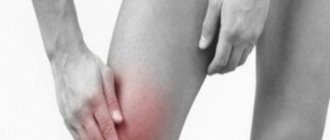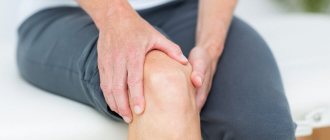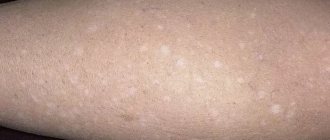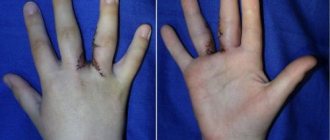The lower limbs bear the entire load of the body, which is why they are most susceptible to various physiological changes. When a burning sensation appears in the leg, disturbing not only during work or walking, but even at rest, it is necessary to look for a serious cause of this disorder. Pain may occur in the lower leg or thigh. It all depends on the nature of the pathological abnormalities and the type of load.
Despite the fact that a third of the population experiences a burning sensation in the lower extremities, this symptom is divided into several manifestations:
- Burning pain accompanied by itching and increased skin temperature;
- Numbness of the limbs;
- Joint damage;
- Burning exclusively in muscle fibers;
- At the same time, the foot swells or wounds appear that do not heal for a long time.
Depending on the nature of the symptoms, various diseases or disorders are diagnosed. Pathology can affect muscles, blood vessels, joints, and nerve fibers.
Causal factors that can cause burning in the legs
There are several reasons that can cause burning sensations in the lower extremities. They are classified into:
- External, they are also called external.
- Internal.
The first factors include uncomfortable, constricting shoes; hosiery and trousers are not made of natural, but synthetic material; a specialty that involves being on your feet all the time.
Internal factors include:
- Hormonal imbalance.
- Blood sugar is higher than normal.
- Avitaminosis. Particular attention is paid to the lack of B vitamins.
- Pathology of the vascular system.
- Pathology caused by impaired innervation (impaired nerve function). This is usually associated with previous injuries that affect the brain. This leads to impaired passage of nerve impulses.
- Lesions of the skin on the legs caused by fungal microcells.
Prevention
To prevent leg diseases accompanied by symptoms such as burning, swelling, and a feeling of heaviness, you should pay attention to the following medical recommendations:
- Observe personal hygiene rules.
- Wear comfortable shoes and socks made from natural materials.
- Once a week, do foot baths with the addition of herbal infusions or sea salt.
- Give your body regular, feasible physical activity.
- Take walks.
- Do exercises.
- During pregnancy and vascular diseases, wear compression stockings.
- Undergo preventive medical examinations.
A burning sensation in the legs below the knee can be a sign of very serious illness. Therefore, if you experience constant discomfort accompanied by other alarming symptoms, you need to consult a doctor, determine the causes of the problem and undergo appropriate treatment.
Burning above the knee: treatment of the main provocateurs
Much less often such symptoms occur when the patient has a burning leg in the thigh area. This is due to the fact that almost any of the diseases listed above primarily affect the limbs below the knee joint. If they rise above the knee, then this is a signal of some serious pathological change, more affecting large joints and the spine.
Sometimes burning pain in the thigh is combined with numbness. Moreover, not a simple tingling sensation, as with impaired blood flow, but a real loss of sensitivity of the skin and muscles. Such signs indicate a blockage of nerve impulses transmitted to the brain. Let's consider common pathologies of the limbs above the knee joint.
- Femoral nerve neuropathy. Characterized by destruction of nerve endings (after exposure to infections or damage/compression of roots). Treatment depends on the cause of the disorder. If this is nerve compression, then special physical procedures and massages are performed. When the lesion is caused by an infection, antibiotics are prescribed. At the same time, anti-inflammatory drugs and drugs are taken to restore blood flow, regenerate damaged tissues and nerve fibers.
- Spinal damage. This includes radiculitis, hernia, disc displacement, vertebral injuries, etc. To solve the problem, both manual therapy and medication are used. In difficult situations, surgery is performed.
- Neuralgia. When the femoral nerve is damaged, different symptoms are observed, depending on the location of the pathology. They get worse when walking or standing. Treatment uses corticosteroids, massages, compresses, and medications to relax muscles.
It is important to note that some diseases have similar symptoms, so in any case it is necessary to undergo diagnostics to make an accurate diagnosis. You should not self-medicate, because a burning sensation in the leg may be a sign of a serious disorder of the spine, systemic organs, blood flow or nerve fibers. Trust the therapy to specialists.
The causes of pain and burning in the legs can be different - from wearing uncomfortable shoes, a sedentary lifestyle and ending with serious disorders in the functioning of internal organs and systems.
A burning sensation in the leg above the knee may be associated with a disease of the musculoskeletal system, endocrine, and vascular pathologies. Often it is symptomatic and occurs due to physiological changes in the body - the causes of burning in the leg below the knee are pregnancy, menopause, etc.
A feeling of burning pain and heat in the legs are signs associated with impaired circulatory processes in the extremities. They can be provoked by diseases - thrombophlebitis, varicose veins, disorders of the venous outflow of blood in the knee joint.
In such conditions, patients exhibit clinical symptoms:
- the veins in the legs burn and protrude above the surface of the skin;
- swelling in the foot and ankle area;
- numbness, decreased sensitivity;
- redness, hyperemia of the skin;
- the appearance of compactions and tumor growths in the area of the affected areas of the legs.
Burning sensations in the leg muscles, itching, and discomfort may be the result of a progressive course of endocrine diseases. Such pathologies are accompanied by general weakness, increased fatigue, and joint damage. With endocrine disorders, the legs in most cases bake and hurt at night or after physical activity.
Tingling and burning in the legs often cause nervous disorders and vascular pathologies. The appearance of burning sensations and heat is due to impaired blood circulation and nutrition in the tissues of the blood vessels of the legs.
Nervous and vascular pathologies are characterized by the following clinical symptoms:
- feeling of goosebumps;
- skin itching;
- changes in blood pressure;
- emotional instability;
- sleep disorders;
- depressive states;
- muscle weakness.
As the pathology progresses, the person becomes lethargic, passive, and apathetic. Periodically, decreased sensitivity may occur in the calf muscle or other areas of the body.
Before prescribing treatment for diseases whose symptom is burning in the legs, it is necessary to reliably establish the causes of such symptoms. In clinical practice, there are about a dozen ailments that can manifest themselves as burning pain or a feeling of heat in the knee, thigh, lower leg or feet.
- Pathologies of blood vessels - varicose veins, thrombophlebitis or endarteritis in an obliterating form.
- Systemic diseases associated with metabolic disorders and endocrine pathologies - diabetes, gout and others.
- Pathological conditions caused by impaired nerve conduction - polyneuropathy, vegetative-vascular dystonia, inflammation of the nerve fiber.
- Congenital or acquired pathologies of joints and bones.
- Autoimmune, including allergies.
- Fungal.
In addition, burning in the knees, below and above them can be caused by conditions not associated with pathologies of internal organs and systems, as well as diseases of the musculoskeletal system.
Often the causes of such symptoms are temporary hormonal or physical changes, for example, during pregnancy or wearing uncomfortable shoes. As a rule, in these cases, patients do not require any treatment, and the ailment in the legs goes away after the completion of gestation or a more reasonable approach to choosing shoes. In other cases, patients require full therapy, including surgery.
Disruption of venous or arterial blood flow in the knee joint or any other area of the legs inevitably leads to discomfort.
- bulging veins above the surface of the skin;
- redness of the skin directly above the pathologically modified vessels;
- sudden cramp in the leg muscles resulting from a sudden change in temperature or increased stress;
- heaviness in the legs and a feeling of numbness in their lower part;
- swelling manifested in the foot or ankle area;
- the formation of compactions on the thigh, but more often - under the knee or on the lower leg, which can be felt when palpated.
Unfortunately, the described symptoms in most cases indicate the rapid progression of pathologies of the veins and arteries, which are unlikely to be cured using only conservative methods (using ointments, tablets and wearing compression garments).
The main way to completely eliminate varicose veins is a full-fledged surgical or minimally invasive treatment, which consists of removing dilated veins or sclerotizing them with a laser or chemicals.
Endarteritis and thrombophlebitis on the legs above and below the knees are also treated with surgery and regular use of medications, the effect of which is to change blood viscosity downwards. If the damage to the vessels is too deep, their complete removal is indicated.
Video
Video - Exercises to prevent varicose veins and leg fatigue
No less common causes of itching and burning in muscles, joints and skin are endocrine disorders. These include diabetes mellitus and gout. These pathologies cause systemic failures, leading to changes in nerve fibers and roots, blood vessels, bone tissue and muscles.
In addition to burning, these pathologies cause increased thirst
To eliminate such symptoms, it is not enough to apply compresses and take medications prescribed by your doctor. Diabetes mellitus, as well as gout, require complete lifestyle changes. Normalizing metabolism by changing the diet and reviewing the patient’s physical activity is the only way to stabilize his condition.
Unfortunately, there are currently no medications that can completely cure diabetes and gout. That is why doctors are increasingly prescribing symptomatic remedies, including folk remedies, which help make it easier to endure exacerbations of the disease.
Vegetative-vascular dystonia and polyneuropathy can also cause a burning sensation in the lower extremities below or above the knee joints and even in the foot. The mechanism for the development of discomfort in this case is a disruption in the nutrition of the tissues of the limbs and/or a disruption in the transmission of impulses.
- crawling sensation in the legs, as well as itching;
- loss of sensation in certain areas of the body;
- dizziness and weakness;
- sudden changes in blood pressure and mood.
Another attack, especially with vegetative-vascular dystonia, can be triggered by hypothermia, nervous shock or a stressful situation. It was these factors that influenced the treatment regimen for burning in the thigh or other part of the limb. The main points of therapy are the use of restoratives, sedatives and physiotherapy. In some cases, folk remedies in the form of herbal teas or baths help achieve positive dynamics.
For polyneuropathy, treatment consists of taking medications whose action is aimed at eliminating the burning problem and suppressing the inflammatory process in the nerve fibers.
- NSAIDs to relieve symptoms;
- hormonal anti-inflammatory drugs (corticosteroids);
- neuroprotectors;
- analgesics;
- means for improving blood circulation in the lower extremities;
- thiocotic acid preparations.
In addition, the therapy includes physiotherapy: electrophoresis, paraffin wraps and applications, massage and exercise therapy.
The most common reasons for a burning sensation in the thigh, as well as below the knee joint, are congenital and acquired pathologies of bones, cartilage and ligaments. With such anomalies, the destructured elements of the joints irritate the nerve endings, which is why itching and a burning sensation occur.
Similar symptoms also occur in the case of pinched nerve roots in the lumbosacral spine. Unlike the previous case, the symptom begins in the thigh and spreads down to the feet. According to statistics, most often a pinched nerve occurs on the right leg.
Treatment of destructive diseases of the joints and bones, which cause a burning sensation and itching in the legs,
- Elimination of pain and other symptomatic manifestations in the knee area or the entire leg.
- Reducing inflammatory processes.
- Restoration of destroyed tissues or inhibition of degenerative processes.
- Strengthening muscle and ligament structures, especially the knee joint.
Neuropathies
Such “burning” discomfort is often felt by patients with polyneuropathies. Most are diagnosed with endocrine pathologies (mainly diabetes mellitus). In addition to this, there are other manifestations of damage to neural fibers:
- Stable and intense pain.
- Numbness, tingling, “pins and needles.”
- Trophic transformations of the skin.
The distal legs are usually involved initially. Usually, in the case of subsequent progression of the pathology, other areas of the peripheral nervous system are also involved in the pathological process.
What pathological processes are indicated by burning sensations in the legs?
A burning sensation can be diagnosed:
- For diabetes mellitus.
- For varicose veins of the lower extremities.
- For fungal infections of the feet.
- For prostatitis or inflammation of the prostate gland.
- For diseases of the spinal column - osteochondrosis.
- For vegetative-vascular dystonia (VSD).
- With neurosis.
- With hereditary predisposition.
- During pregnancy.
Diabetes
Diabetes mellitus is characterized by the symptom of diabetic neuropathy, which occurs due to damage to the vessels of the capillary network. Their defeat leads to the fact that the nerve endings begin to have poor blood supply. As a result, the patient experiences a feeling of crawling, tingling and burning sensations in the legs. If you press on your toes, pain reflexively occurs, spreading from the foot and above.
With varicose veins, in addition to burning, there are other symptoms: swelling of the lower extremities, which manifests itself towards the end of the day, spider veins, muscle cramps, which often appear at night. Either pain or a feeling of fullness appears in the calves of the legs.
If a fungus appears, then the clinical picture has the following characteristics:
- A burning and itching sensation appears at the site of the fungus.
- Symptoms are present throughout the day.
- The disease does not go away on its own. If antifungal therapy is not started in a timely manner, the clinical picture becomes clearer.
For prostatitis
If a man has a history of prostatitis, then the following manifestations are possible:
- Aching pain appears in the projection of the inner thigh. In this case, patients report a feeling of squeezing of blood vessels.
- There is a burning sensation and shooting sensations in the legs below the knee, as if they were burning with fire.
- The pain symptom is not always present. It appears spontaneously and goes away on its own.
For osteochondrosis
The disease osteochondrosis is characterized by pain in the lumbar region, gradually the pain begins to spread towards the hips and calf muscles. Usually only one of the lower extremities is involved in the pathological process. In addition to pain, there is lameness, muscle cramps, weakness in the legs and numbness in the lower half of the body. During movement, tingling and burning sensations appear above the knee.
VSD is characterized by burning sensations of different localization (in the legs, torso, upper extremities, legs), but most often it is observed in the legs. With this disease, patients note increased weakness, fatigue, and problems sleeping. They are thrown either hot or cold. The sweat glands work more actively than usual, which leads to increased sweating. Hands and feet with VSD are always cold.
Neurosis
With neurosis, pain most often appears in the joints of the lower extremities. Such patients step on their feet with caution, because there is a feeling of paralysis of the legs. Their gait is uncertain and shaky. They cannot walk or even stand for a long time. Symptoms usually appear in the tissue below the knee and are characterized by numbness, squeezing and a stinging sensation as if stung by nettles.
In pregnant women
During pregnancy, not everyone experiences a burning sensation in their legs. This is usually a manifestation of gestosis (complication) in late pregnancy. Because the disease is characterized by severe swelling and increased pressure, compression of blood vessels occurs and deterioration of blood supply to the tissues of the lower extremities. This leads to pain and burning.
- For diabetes mellitus.
- For varicose veins of the lower extremities.
- For fungal infections of the feet.
- For prostatitis or inflammation of the prostate gland.
- For diseases of the spinal column - osteochondrosis.
- For vegetative-vascular dystonia (VSD).
- With neurosis.
- With hereditary predisposition.
- During pregnancy.
diagnosis-med.ru
The lower limbs bear the entire load of the body, which is why they are most susceptible to various physiological changes. When a burning sensation appears in the leg, disturbing not only during work or walking, but even at rest, it is necessary to look for a serious cause of this disorder. Pain may occur in the lower leg or thigh. It all depends on the nature of the pathological abnormalities and the type of load.
Despite the fact that a third of the population experiences a burning sensation in the lower extremities, this symptom is divided into several manifestations:
- Burning pain accompanied by itching and increased skin temperature;
- Numbness of the limbs;
- Joint damage;
- Burning exclusively in muscle fibers;
- At the same time, the foot swells or wounds appear that do not heal for a long time.
Depending on the nature of the symptoms, various diseases or disorders are diagnosed. Pathology can affect muscles, blood vessels, joints, and nerve fibers.
Pathologies of the musculoskeletal system
Such ailments can cause a burning sensation in the right or left thigh, ankle, knee joint and even fingers. Unpleasant symptoms are caused by diseases, degenerative changes in bone and cartilage tissue, muscles or ligaments.
Destructive articular elements irritate the nerve endings, which is accompanied by a burning sensation. In diseases of the locomotor system, discomfort in most cases is localized exclusively in the right or left leg, spreading from the femur to the foot.
If your legs ache, ache and there is a burning sensation, the cause is traumatic injuries or mechanical impacts. Similar symptoms are typical for bruises, sprains, fractures and appear during the first day after injury.
When damaged, patients complain of:
- severe swelling;
- hematomas, internal hemorrhages;
- pronounced pain syndrome inside the injured limb;
- deformation
The cause of burning in the legs is often an allergic reaction. It can be provoked by medications, the use of chemicals, wearing clothes or stockings made of synthetic materials.
You can suspect an allergy if the skin is red and swollen. Patients often complain of itching and urticaria-type rashes, hyperemia. In such a situation, you should avoid contact with allergens and consult a doctor to prescribe antihistamines.
Diabetes
Diabetic pathology can cause a feeling that the skin on the legs is burning, a burning sensation in the calves. The presence of the disease is indicated by:
- increased urge to urinate;
- constant feeling of thirst;
- erectile dysfunction in men;
- swelling of the lower and upper extremities;
- ulcerative skin lesions.
If you discover at least some of the listed symptoms, immediately contact a specialist, since diabetes mellitus must be treated competently and in a timely manner.
Heel spur
This is a disease with concomitant pathological growth of the heel bone, the formation of sharp spines on it. Pathological changes of this kind are accompanied by pain and burning exclusively in the area of the sole and heel. Symptoms intensify as the pathological process progresses.
Fungal infection
It affects the skin of the toes, gradually spreading to the area of the foot and ankle. Specific signs will help to pre-diagnose the fungus:
- peeling and redness in the affected area;
- burning and itching;
- the appearance of painful cracks;
- unpleasant smell.
To combat fungal infections, special ointments and antimycotic drugs are used, which are selected individually depending on the specific pathogen.
Etiology of the condition
Unpleasant sensations localized in the lower legs manifest themselves due to pathological processes:
- Thrombophlebitis is inflammation of the walls of the veins and the formation of dense blood clots in them. The pathology requires urgent treatment to avoid death.
- Varicose veins or varicose veins are a chronic pathology in which nodular dilations form along the entire length of the veins. At the same time, the outflow of blood is disrupted, and a stagnation process is formed.
- Obliterating endarteritis is a lesion of vessels of small cross-sectional diameter. The pathology develops quickly, so the scale of the lesion increases in a short time.
- Atherosclerosis of the lower extremities is a chronic disease that is formed against the background of the accumulation of cholesterol in medium and large arteries and their damage.
- Polyneuropathy is a group of pathologies that cause damage to nerve endings. Characteristic symptoms are muscle weakness, burning and pain in the legs below the knee.
- Pathological disorders of the lumbar and sacral spine.
- Vegetative-vascular dystonia is a disease that affects the entire body. Most often, the peripheral nerves, heart, and vascular system are affected. Unpleasant, obsessive sensations in the legs are evidence of the last stages of development of vegetative-vascular dystonia.
- Diabetes mellitus is a chronic disease that disrupts the functioning of the endocrine system. Painful sensations in the lower extremities are a consequence of changes in the glucose processing system.
- Disorders in the metabolic system.
- Pathologies of fungal nature.
- Pathologies of the musculoskeletal system.
- Gout is a chronic disease accompanied by impaired uric acid metabolism. The main clinical picture is recurrent arthritis, most often affecting the foot. Patients with gout complain of a feeling of warmth in the leg just below the knee.
- Flat feet is a deformation of the foot, leading to loss of shock-absorbing and spring functions. As a result, the load on the knee joint increases, and unpleasant sensations appear in the legs while walking.
A separate group of causes of burning in the lower extremities includes etiological factors that are not considered as independent diseases:
- allergic reactions;
- mechanical damage to the leg;
- physical and static loads;
- incorrect selection of shoes;
- stressful situations, nervous overstrain.
A separate group of causes of burning in the lower extremities includes etiological factors that are not considered as independent diseases:
- Thrombophlebitis is inflammation of the walls of the veins and the formation of dense blood clots in them. The pathology requires urgent treatment to avoid death.
- Varicose veins or varicose veins are a chronic pathology in which nodular dilations form along the entire length of the veins. At the same time, the outflow of blood is disrupted, and a stagnation process is formed.
- Obliterating endarteritis is a lesion of vessels of small cross-sectional diameter. The pathology develops quickly, so the scale of the lesion increases in a short time.
- Atherosclerosis of the lower extremities is a chronic disease that is formed against the background of the accumulation of cholesterol in medium and large arteries and their damage.
- Polyneuropathy is a group of pathologies that cause damage to nerve endings. Characteristic symptoms are muscle weakness, burning and pain in the legs below the knee.
- Pathological disorders of the lumbar and sacral spine.
- Vegetative-vascular dystonia is a disease that affects the entire body. Most often, the peripheral nerves, heart, and vascular system are affected. Unpleasant, obsessive sensations in the legs are evidence of the last stages of development of vegetative-vascular dystonia.
- Diabetes mellitus is a chronic disease that disrupts the functioning of the endocrine system. Painful sensations in the lower extremities are a consequence of changes in the glucose processing system.
- Disorders in the metabolic system.
- Pathologies of fungal nature.
- Pathologies of the musculoskeletal system.
- Gout is a chronic disease accompanied by impaired uric acid metabolism. The main clinical picture is recurrent arthritis, most often affecting the foot. Patients with gout complain of a feeling of warmth in the leg just below the knee.
- Flat feet is a deformation of the foot, leading to loss of shock-absorbing and spring functions. As a result, the load on the knee joint increases, and unpleasant sensations appear in the legs while walking.
The problem sometimes lies in the poor quality of the fabrics from which:
- tights;
- socks;
- tight pants.
Other substances that cause allergies:
- self-tanning creams;
- lotions;
- depilatory products.
What to do, which doctor to contact if there is a burning sensation in the legs
You can first make an appointment with a therapist, and he will give you a referral to other doctors. Specialists conduct a full examination and prescribe a set of necessary tests:
- Laboratory testing of blood and urine. The blood test is not only general. Examine the level of glucose in it.
- Analysis of the concentration of vitamins and microelements.
- Blood test for hormone levels. Required if there is a suspicion of hormonal imbalance.
- Electromyography, to study the functioning of muscle fibers.
- Nerve conduction studies to confirm normal functioning of the nervous system.
- Vascular surgeon.
- Endocrinologist.
- Neurologist.
- Dermatologist.
Help from doctors
As a rule, when discomfort occurs in their legs, people do not rush to see a doctor. But in vain, since such symptoms may indicate the presence of sclerotic plaques and blood clots, which often cause death.
Doctors' help should be sought immediately if numbness in the leg, sharp pain, lack of former mobility of the lower extremities, as well as dizziness, headaches, nausea and vomiting, and heart pain occur.
If the above symptoms are detected, doctors will conduct a full examination. If formations dangerous to human life are detected, surgery is performed immediately.
Surgery is also performed due to:
- the onset of trophic changes in the skin;
- presence of blood clots;
- extensive varicose veins;
- blood flow disorders.
Impaired blood flow often causes heart attack, stroke and other serious damage to organs and the body as a whole.
Take care of your feet from a young age
To keep your legs healthy and strong, use the following recommendations:
- give up bad habits;
- give up high heels and uncomfortable shoes;
- try to walk more and just stand in one place less;
- lead an active lifestyle by replacing a comfortable sofa with walks in the park;
- take a complex of vitamins;
- use folk recipes to eliminate swelling;
- use the medications given above to prevent vascular diseases;
- do not visit baths and saunas;
- Water your feet with cool water every time you shower.
Following these recommendations will help you avoid unpleasant and quite dangerous diseases, as well as their consequences.

